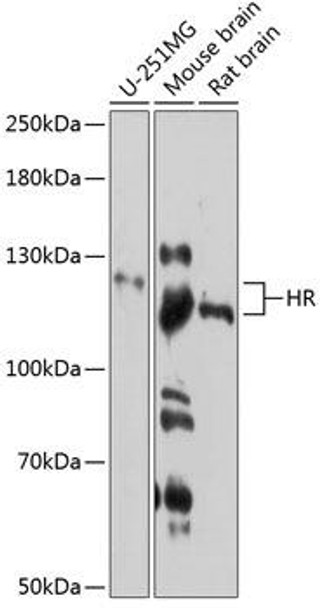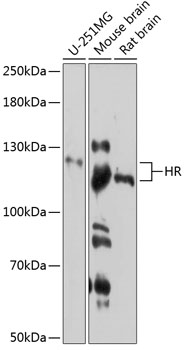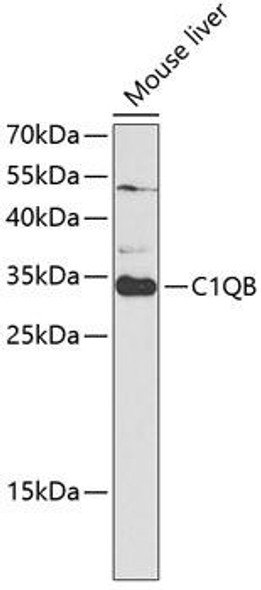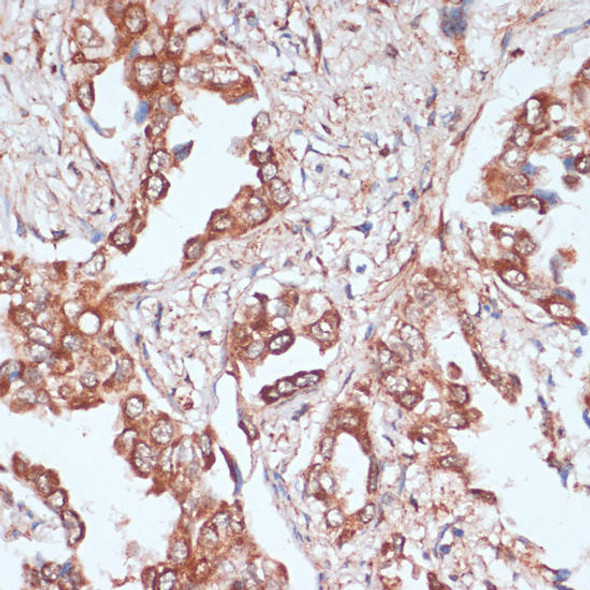Anti-HR Antibody (CAB11996)
- SKU:
- CAB11996
- Product type:
- Antibody
- Reactivity:
- Human
- Mouse
- Rat
- Host Species:
- Rabbit
- Isotype:
- IgG
- Antibody Type:
- Polyclonal Antibody
- Research Area:
- Epigenetics and Nuclear Signaling
Frequently bought together:
Description
| Antibody Name: | Anti-HR Antibody |
| Antibody SKU: | CAB11996 |
| Antibody Size: | 20uL, 50uL, 100uL |
| Application: | WB |
| Reactivity: | Human, Mouse, Rat |
| Host Species: | Rabbit |
| Immunogen: | Recombinant fusion protein containing a sequence corresponding to amino acids 200-480 of human HR (NP_005135.2). |
| Application: | WB |
| Recommended Dilution: | WB 1:500 - 1:1000 |
| Reactivity: | Human, Mouse, Rat |
| Positive Samples: | U-251MG, Mouse brain, Rat brain |
| Immunogen: | Recombinant fusion protein containing a sequence corresponding to amino acids 200-480 of human HR (NP_005135.2). |
| Purification Method: | Affinity purification |
| Storage Buffer: | Store at -20°C. Avoid freeze / thaw cycles. Buffer: PBS with 0.02% sodium azide, 50% glycerol, pH7.3. |
| Isotype: | IgG |
| Sequence: | SLGS KGFY YKDP SIPR LAKE PLAA AEPG LFGL NSGG HLQR AGEA ERPS LHQR DGEM GAGR QQNP CPLF LGQP DTVP WTSW PACP PGLV HTLG NVWA GPGD GNLG YQLG PPAT PRCP SPEP PVTQ RGCC SSYP PTKG GGLG PCGK CQEG LEGG ASGA SEPS EEVN KASG PRAC PPSH HTKL KKTW LTRH SEQF ECPR GCPE VEER PVAR LRAL KRAG SPEV QGAM GSPA PKRP PDPF PGTA EQGA GGWQ EVRD TSIG NKDV DSGQ HDEQ KGPQ DGQA SLQD P |
| Gene ID: | 55806 |
| Uniprot: | O43593 |
| Cellular Location: | Nucleus |
| Calculated MW: | 121kDa/127kDa |
| Observed MW: | 120kDa |
| Synonyms: | HR, ALUNC, AU, HSA277165, HYPT4, MUHH, MUHH1 |
| Background: | This gene encodes a protein that is involved in hair growth. This protein functions as a transcriptional corepressor of multiple nuclear receptors, including thyroid hormone receptor, the retinoic acid receptor-related orphan receptors and the vitamin D receptors, and it interacts with histone deacetylases. The translation of this protein is modulated by a regulatory open reading frame (ORF) that exists upstream of the primary ORF. Mutations in this upstream ORF cause Marie Unna hereditary hypotrichosis (MUHH), an autosomal dominant form of genetic hair loss. Mutations in this gene also cause autosomal recessive congenital alopecia and atrichia with papular lesions, other diseases resulting in hair loss. Two transcript variants encoding different isoforms have been found for this gene. |
| UniProt Protein Function: | HR: May act as a transcription factor that could act on to regulate one of the phases of hair growth. Defects in HR are the cause of alopecia universalis congenita (ALUNC). ALUNC is a rare autosomal recessive form of hair loss characterized by hair follicles without hair. Defects in HR are the cause of atrichia with papular lesions (APL); also known as congenital atrichia. APL is an autosomal recessive disease characterized by papillary lesions over most of the body and almost complete absence of hair. Defects in HR are the cause of hypotrichosis type 4 (HYPT4). An autosomal dominant condition characterized by reduced amount of hair, alopecia, little or no eyebrows, eyelashes or body hair, and coarse, wiry, twisted hair in early childhood. 2 isoforms of the human protein are produced by alternative splicing. |
| UniProt Protein Details: | Protein type:Nuclear receptor co-regulator; Transcription, coactivator/corepressor Chromosomal Location of Human Ortholog: 8p21.3 Cellular Component: chromatin; nucleoplasm; nucleus Molecular Function:chromatin DNA binding; histone demethylase activity (H3-K9 specific) Biological Process: histone H3-K9 demethylation; regulation of transcription, DNA-dependent Disease: Alopecia Universalis Congenita; Atrichia With Papular Lesions; Hypotrichosis 4 |
| NCBI Summary: | This gene encodes a protein that is involved in hair growth. This protein functions as a transcriptional corepressor of multiple nuclear receptors, including thyroid hormone receptor, the retinoic acid receptor-related orphan receptors and the vitamin D receptors, and it interacts with histone deacetylases. The translation of this protein is modulated by a regulatory open reading frame (ORF) that exists upstream of the primary ORF. Mutations in this upstream ORF cause Marie Unna hereditary hypotrichosis (MUHH), an autosomal dominant form of genetic hair loss. Mutations in this gene also cause autosomal recessive congenital alopecia and atrichia with papular lesions, other diseases resulting in hair loss. Two transcript variants encoding different isoforms have been found for this gene. [provided by RefSeq, Oct 2014] |
| UniProt Code: | O43593 |
| NCBI GenInfo Identifier: | 115502396 |
| NCBI Gene ID: | 55806 |
| NCBI Accession: | O43593.5 |
| UniProt Secondary Accession: | O43593,Q6GS30, Q96H33, Q9NPE1, |
| UniProt Related Accession: | O43593 |
| Molecular Weight: | 127kDa |
| NCBI Full Name: | Lysine-specific demethylase hairless |
| NCBI Synonym Full Names: | HR, lysine demethylase and nuclear receptor corepressor |
| NCBI Official Symbol: | HR |
| NCBI Official Synonym Symbols: | AU; MUHH; ALUNC; HYPT4; MUHH1; HSA277165 |
| NCBI Protein Information: | lysine-specific demethylase hairless |
| UniProt Protein Name: | Lysine-specific demethylase hairless |
| Protein Family: | Hrp65 protein |
| UniProt Gene Name: | HR |








